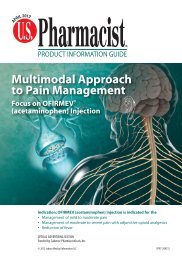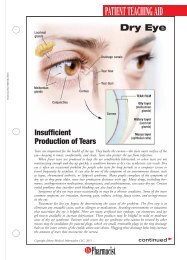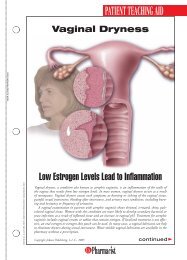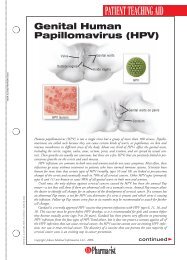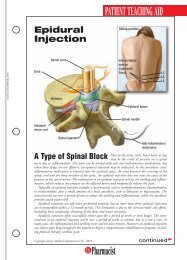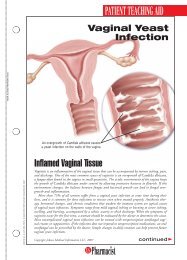View PDF Edition - U.S. Pharmacist
View PDF Edition - U.S. Pharmacist
View PDF Edition - U.S. Pharmacist
You also want an ePaper? Increase the reach of your titles
YUMPU automatically turns print PDFs into web optimized ePapers that Google loves.
PROGRESSIVE SUPRANUCLEAR PALSYlability (with a propensity tolaugh or cry easily) is referred toas pseudobulbar affect. 2 Rigidity,bradykinesia, and dystonic neckextension may be present, andlanguage functions resemble thoseevident in PD (i.e., speech maybecome incomprehensible, repetitive/babbling,or mute). 1-3,7 Whileonly occasional, a subtle restingtremor may be present. 2Deficits, similar to those secondaryto multiple strokes, occurin a progressive and usually rapidfashion. 2 In terms of the patient’scognition, mental slowing, executivedysfunction (i.e., impairmentof volitional activities such asplanning, organizing, self-awareness,self-regulation, and initiationof action), and memoryimpairment (less severe than inAlzheimer’s disease) occur. 1,3,6Later in the disease, depressionand dementia are common, causingsome individuals to experiencesleep disturbances, agitation,and irritability. 2,3 Eventually, mostPSP patients require a wheelchairand a feeding tube. 7Upon initially seeing a patientwith symptoms of PSP, pharmacistsmay recognize symptomsthat resemble drug-inducedpseudoparkinsonism, most commonlyseen with the use of firstgenerationantipsychotic agents ofthe phenothiazine (e.g., chlorpromazine),thioxanthene (e.g., thiothixene),or butyrophenone (e.g.,haloperidol) classes. Based on theparkinsonian signs and symptomsand considering that the coresymptom of vertical supranucleargaze palsy is not always present inthe early stage of PSP, it is notdifficult to understand how thisdisease may be misdiagnosed asPD, especially since diagnosis isdetermined clinically and not byany substantiating diagnostic test.Schmidt et al note the mostimportant features that characterizeand differentiate PSP fromother parkinsonian syndromes asTable 1Potential Symptoms of ProgressiveSupranuclear Palsy• Loss of voluntary eye movements; particular difficulty with vertical movements,referred to as vertical supranuclear gaze palsy; inability to fix gaze on a stationaryor moving object (square wave jerks). Reflexive eye movements are unaffected• Other ophthalmic signs and symptoms include blurred vision, diplopia, photophobia,burning, tearing, and upper eyelid retraction• Postural instability causing falls (specifically a tendency to fall backward)• Bradykinesia• Muscular rigidity with progressive dyskinetic movements due to disorderedtonicity of muscle (e.g., dystonic neck extension); subtle resting tremor(usually absent)• Pseudobulbar palsy: difficulty swallowing (dysphagia) and speech disturbance(dysarthria) with emotional lability• Cognitive impairment (e.g., mental slowing, executive dysfunction, memoryimpairment)• Sleep disturbances (insomnia or hyposomnia)• Agitation, irritability, disinhibition• Depression (late in course)• Dementia (eventually occurs)Source: References 1-3, 6, 7, 16.the following: 1) supranucleargaze palsy; 2) postural instability;3) pseudobulbar palsy; and 4)cognitive disturbances. 10 Litvanet al indicate that which specificallydifferentiates PSP fromother diseases: 1) PSP from PD isunstable gait, absence of tremordominantdisease, and absence ofa response to levodopa; 2) PSPfrom diffuse Lewy body disease issupranuclear vertical gaze palsy,gait instability, and the absenceof delusions; 3) PSP from Pick’sdisease is postural instability; 4)PSP from multiple system atrophyis supranuclear vertical gazepalsy and increased age at symptomonset; and 5) PSP from corticobasaldegeneration is gaitabnormality, severe upward gazepalsy, bilateral bradykinesia, andabsence of alien limbsyndrome. 11Significant autonomic dysfunctionmay be seen in patients withPSP as well as in patients withPD. 10 According to Schmidt et al,the parasympathetic cardiovascularsystem appears to be involved to asimilar extent in patients with PDand patients with PSP, as comparedto sympathetic cardiovasculardysfunction, which is morefrequent and severe in patientswith PD but can also be seen inpatients with PSP. 10TreatmentPSP is an incurable condition.Treatment is supportive and far lesseffective than that for Parkinson’sdisease. 2 The treatment of PSPremains unsatisfactory, since onlyoccasionally do levodopa,dopamine agonists (TABLE 2),amantadine, or amitriptyline partiallyrelieve rigidity. 1,2 It is presumedthat the reason PSP is notresponsive to dopamine replacementor dopamine agonist therapiesis that dopamine receptorsare decreased as a result of postsynapticdamage beyond pathologicalchanges seen in PD. 12 Symptomatictreatment with drugs andother therapies should be targetedat reducing morbidity andimproving quality of life (e.g.,depression can be treated with21U.S. <strong>Pharmacist</strong> • November 2009 • www.uspharmacist.com





